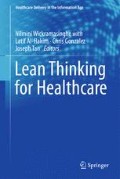Abstract
Chronic diseases are increasing exponentially and by their very nature and definition mean that no cure is in sight. One such chronic disease is diabetes. The WHO has described diabetes as a silent epidemic given the current number of sufferers and future projections of increased number of individuals who are expected to contract diabetes. While globally the numbers of diabetic sufferers are alarming, in some segments of the community there is significant overrepresentation due to many factors including ineffective and inefficient healthcare delivery processes. The following proffers a disruptive, pervasive technology solution as a way to not only facilitate superior care for diabetic patients but also enable needed healthcare delivery process redesign.
An earlier version of this material was presented at the 2011 HICSS conference, 4–7 Jan, Kuai, Hawaii.
Access this chapter
Tax calculation will be finalised at checkout
Purchases are for personal use only
References
Acton, K., Burrows, N., Moore, K., Querec, L., Geiss, L., & Engelgau, M. (2002). Trends in diabetes prevalence among American Indian and Alaska Native children, adolescents and young adults. American Journal of Public Health, 92(9), 1485–1490.
Boyatsis, R. (1998). Transforming qualitative information. Thousand Oaks: Sage.
Burrows, N., Geiss, L., Engelgau, M., & Acton, K. (2000). Prevalence of diabetes among Native Americans and Alaska Natives 1990–1997. Diabetes Care, 23(12), 1786–1790.
Cellular News. http://www.cellular-news.com/story/15627.php
Cullen, T. (2001). Standards and the computerized patient record. IHS Primary Care Provider., 26(4), 58–59.
Cunningham, P. J. (1993). Access to care in the Indian Health Service. Health Affairs, 12(3), 224.
Gibbons, M., Bali, R., & Wickramasinghe, N. (2010). Perspectives of knowledge management in urban healthcare. New York: Springer.
Goldberg, S. (2002a). Building the evidence for a standardized mobile internet (wireless) environment in Ontario, Canada. January Update, Internal INET Documentation, Ontario, Canada, INET.
Goldberg, S. (2002b). HTA Presentation rendering component summary. Internal INET documentation, Ontario, Canada, INET.
Goldberg, S. (2002c). HTA presentational selection and aggregation component summary. Internal INET Documentation, Ontario, Canada, INET.
Goldberg, S. (2002d). HTA quality assurance component summary. Internal INET documentation, Ontario, Canada, INET.
Goldberg, S. (2002e). Wireless POC device component summary. Internal INET documentation, Ontario, Canada, INET.
Hays, H. (2003). The IHS electronic health record project. IHS Primary Care Provider, 28(11), 233–236.
Kavale, S. (1996). Interviews. Thousand Oaks: Sage.
Lautenschlager, L., & Smith, C. (2006). Low-income American Indians’ perceptions of diabetes. Journal of Nutrition Education and Behavior, 38(5), 307–315.
Miller, D. R., Safford, M. M., & Pogach, L. M. (2004). Who has diabetes? Best estimates of diabetes prevalence in the department of Veterans Affairs based on computerised patient data. Diabetes Care, 27(Suppl. 2), B10–B21.
Mirza, F., Norris, T., & Stockdale, R. (2008). Mobile technologies and the holistic management of chronic diseases. Health Informatics Journal, 14(4), 309–321.
Ogunwole, S. U. (2006). We the people: American Indians and Alaskan Natives in the United States. Census 2000 Special Reports, Issues Feb. Retrieved December, 2009, from http://www.census.gov/population/www/socdemo/race/censr-28.pdf.
Opie, A. (1998). Nobody’s asked me for my view: Users’ empowerment by multidisciplinary health teams. Qualitative Health Research, 18, 188–206.
Parker, J. D., Schenker, N., Ingram, D. D., Weed, J. A., Heck, K. E., & Madans, J. H. (2004). Bridging between two standards for collecting information on race and ethnicity: An application to Census 2000 and vital rates. Public Health Reports, 119(2), 192–205.
Porter, M., & Tiesberg, E. (2006). Re-defining health care delivery. Boston: Harvard Business Press.
Rachlis, M. (2006). Key to sustainable healthcare system. Retrieved February, 2008, from http://www.improveingchroniccare.org.
Radin, P. (2006). To me, it’s my life: Medical communication, trust, and activism in cyberspace. Social Science & Medicine, 6, 591–601.
Sequist, T. D., Cullen, T., & Ayanian, J. Z. (2005). Information technology as a tool to improve the quality of American Indian health care. American Journal of Public Health, 95(12), 2173–2179.
Stratton, I. (2000). UKPDS. British Medical Journal, 321, 405–412.
WHO. (2002). Innovative care for chronic conditions: Building blocks for action: Global report. Geneva: Noncommunicable Diseases and Mental Health, World Health Organization.
Wickramasinghe, N., & Goldberg, S. (2003). The wireless panacea for healthcare. In Proceedings of 36th Hawaii International Conference on System Sciences. Hawaii, 6–10 January, IEEE.
Wickramasinghe, N., & Godlberg, S. (2004). How M = EC2 in Healthcare. International Journal of Mobile Communications, 2(2), 140–156.
Wickramasinghe, N., & Goldberg, S. (2007). Adaptive mapping to realisation methodology (AMR) to facilitate mobile initiatives in healthcare. International Journal of Mobile Communications, 5(3), 300–318.
Wickramasinghe, N., & Goldberg, S. (2009). The S’ANT approach to facilitate a superior chronic disease self-management model. IJANTTI, 1(4), 21–34.
Wickramasinghe, N., & Schaffer, J. (2006). Creating knowledge driven healthcare processes with the intelligence continuum. International Journal of Electronic Healthcare, 2(2), 164–174.
Wickramasinghe, N., & Schaffer, J. (2010). Realizing value driven e-health solutions. Washington, DC: IBM Center for The Business of Government.
Yin, R. (1994). Case study research (2nd ed.). Thousand Oaks: Sage.
Zuckerman, S., Haley, J., Roubideaux, Y., & Lillie-Blanton, M. (2004). Health service access, use, and insurance coverage among American Indians/Alaska Natives and Whites: What role does the Indian health service play? American Journal of Public Health, 94(1), 53–59.
Author information
Authors and Affiliations
Corresponding author
Editor information
Editors and Affiliations
Rights and permissions
Copyright information
© 2014 Springer Science+Business Media New York
About this chapter
Cite this chapter
Chalasani, S., Goldberg, S., Wickramasinghe, N. (2014). The Role of a Disruptive Pervasive Technology Solution to Facilitate Better Healthcare Delivery to Native American Patients. In: Wickramasinghe, N., Al-Hakim, L., Gonzalez, C., Tan, J. (eds) Lean Thinking for Healthcare. Healthcare Delivery in the Information Age. Springer, New York, NY. https://doi.org/10.1007/978-1-4614-8036-5_18
Download citation
DOI: https://doi.org/10.1007/978-1-4614-8036-5_18
Published:
Publisher Name: Springer, New York, NY
Print ISBN: 978-1-4614-8035-8
Online ISBN: 978-1-4614-8036-5
eBook Packages: MedicineMedicine (R0)

